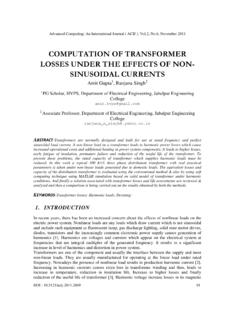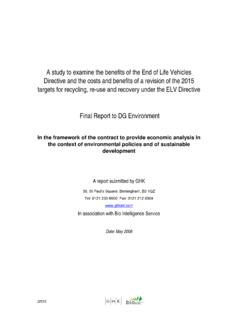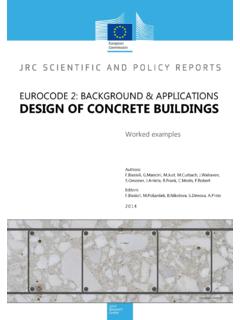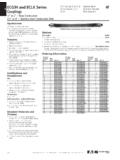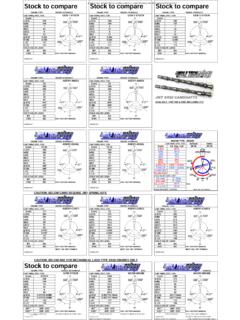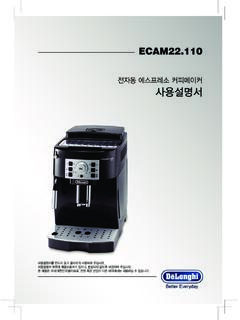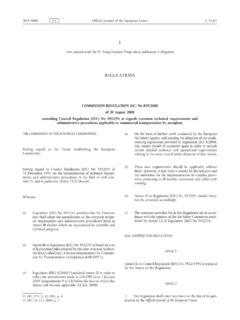Transcription of Guidance document - European Commission
1 1. 2. 3. 4. 5. 6. 7. 8. 9. 10. 11. 12. 13. 14 Guidance document 15. 16 On the definition and classification of hazardous 17 waste 18. 19 DRAFT VERSION from 08 June 2015. 20. mmmll Guidance document on the definition and classification of hazardous waste 21 - This page intentionally left blank - 22. June 2015 I 2. Guidance document on the definition and classification of hazardous waste 23 Table of Contents 24. 25 Table of Contents .. 3. 26 Executive Summary .. 6. 27 List of Abbreviations .. 7. 28 Glossary .. 8. 29 List of Tables ..10. 30 List of Figures ..12. 31 List of Boxes ..13. 32 Foreword ..14. 33 Notice ..15. 34 1. Introduction ..16. 35 Background ..16. 36 To whom is the Guidance addressed?
2 17. 37 How to read the Guidance ? ..17. 38 2. Legislative Framework ..18. 39 Waste Legislation ..18. 40 Waste Framework Directive (WFD) ..18. 41 European List of Waste (LoW) ..19. 42 Waste Shipment Regulation (WSR) ..20. 43 Directive on waste from the extractive industries ..20. 44 REACH Regulation ..21. 45 CLP Regulation ..21. 46 POP Regulation ..22. 47 Seveso III Directive ..23. 48 3. Procedures for the classification of waste ..24. 49 General approach to the classification of waste ..24. 50 Step 1: Is the WFD applicable? ..24. 51 Step 2: Which entry of the List of Waste is applicable? ..26. 52 Assignment of MH or MNH entry ..27. 53 Step 3: Is the waste composition available?
3 27. 54 Step 4: Does the waste display any hazardous properties HP1 to HP15?28. 55 Step 5: Does the waste contain any of the POPs indicated in in the Annex 56 to the LoW (point 2, indent 3)? ..30. 57 4. Annex ..31. 58 Annex A: Annotated List of Waste ..32. June 2015 I 3. Guidance document on the definition and classification of hazardous waste 59 Structure of the LoW ..32. 60 Identifying the appropriate entry ..36. 61 Annotated List of Waste ..38. 62 Examples of the classification of complex entries ..68. 63 Packaging waste and contents ..68. 64 Waste from electrical and electronic equipment (WEEE) ..71. 65 End of life vehicles (ELV) ..73. 66 Examples for the assessment of specific ingredients and compounds of 67 specific waste types.
4 74. 68 Organic ingredients and specific chemical compounds ..74. 69 Substances that deplete the ozone layer ..76. 70 Asbestos and man-made mineral fibres ..77. 71 Wastes containing CaO and Ca(OH)2 ..78. 72 Wastes containing coal tar ..80. 73 Metals and 74 Organic peroxides ..83. 75 Rubber wastes ..84. 76 Plastic wastes ..85. 77 POP wastes ..87. 78 Annex B: Data sources and information basis on hazardous substances ..90. 79 Classification of substances as hazardous according the CLP Regulation ..90. 80 Harmonised classification of substances ..91. 81 Self-classifications ..91. 82 The C&L Inventory as research tool ..92. 83 Information on composition, properties and waste management of products 84 becoming 85 Information on the classification of waste streams.
5 94. 86 Annex C: Specific approaches to determine hazard properties (HP1 to HP15) ..95. 87 Determining HP 1: Explosive ..95. 88 Determining HP 2: Oxidising ..98. 89 Determining HP 3: Flammable .. 101. 90 Determining HP 4: Irritant skin irritation and eye damage .. 105. 91 Determining HP 5: Specific Target Organ Toxicity (STOT) / Aspiration Toxicity 92 .. 109. 93 Determining HP 6: Acute Toxicity .. 112. 94 Determining HP 7: Carcinogenic .. 116. 95 Determining HP 8: 118. 96 Determining HP 9: Infectious .. 121. June 2015 I 4. Guidance document on the definition and classification of hazardous waste 97 Determining HP 10: Toxic for reproduction .. 122. 98 Determining HP 11: Mutagenic.
6 124. 99 Determining HP 12: Release of an acute toxic gas .. 126. 100 Determining HP 13: Sensitising .. 128. 101 Determining HP 14: Ecotoxic .. 130. 102 Determining HP 15: Waste capable of exhibiting a hazardous property listed 103 above not directly displayed by the original waste .. 131. 104 Annex D: Sampling and sample preparation .. 133. 105 133. 106 Sampling 135. 107 Standards for different waste types .. 137. 108 Sampling strategies to deal with homogeneity/ heterogeneity .. 137. 109 Statistical approach of sampling .. 138. 110 Annex E: References .. 139. 111 General references .. 139. 112 Legal acts cited in the document .. 141. 113. 114. June 2015 I 5. Guidance document on the definition and classification of hazardous waste 115 Executive Summary 116 The final Guidance document will contain an executive summary in English and French 117 language.
7 118. June 2015 I 6. Guidance document on the definition and classification of hazardous waste 119 List of Abbreviations 120. 121 ABANDA Database on waste analyses 122 ( Abfallanalysendatenbank'). 123 AH Absolute Hazardous Entry 124 ANH Absolute Non-Hazardous Entry 125 ATP Adaption to Technical Progress 126 BDE Brominated diphenyl ethers 127 BREF Best Available Techniques Reference document 128 BTX Benzene Toluene and Xylene 129 CaO Calcium oxide 130 Ca(OH)2 Calcium hydroxide 131 CEN European Committee for Standardization 132 CJEU Court of Justice of the European Union 133 C&L Classification & Labelling 134 CLP Classification, Labelling and Packaging 135 CLRTAP Convention on Long-Range Transboundary Air 136 Pollution 137 ECHA European Chemicals Agency 138 EEA European Environmental Agency 139 ELV End of life vehicles 140 ETDS Environmental Terminology and Discovery Service 141 GHS Globally Harmonised System 142 HP Hazardous Property 143 LANUV Environment Agency of North Rhine-Westphalia 144 ( Landesamt f r Natur, Umwelt und 145 Verbraucherschutz' Nordrhein-Westfalen').
8 146 LoW List of Waste (Decision 2000/532/EC, as amended). 147 MH Mirror Hazardous Entry 148 MNH Mirror Non-Hazardous Entry 149 ODS Ozone depleting substances 150 OSHA Occupational Safety & Health Administration 151 PAH Polycyclic Aromatic Hydrocarbons 152 SDS Safety Data Sheet 153 UNECE United Nations Economic Commission for Europe 154 WEEE Waste electrical and electronic equipment 155 WFD Waste Framework Directive (2008/98/EC). 156. June 2015 I 7. Guidance document on the definition and classification of hazardous waste 157 Glossary 158. 159 Cut-off value Where a substance is present in the 160 waste below a determined limit value ( 161 its cut-off value), it shall not be included 162 in any calculation of a threshold.
9 Cut-off 163 values for individual substances for the 164 assessment of hazardous properties are 165 indicated in Annex III to the WFD. 166 M-factor M-factor means a multiplying factor. It is 167 applied to the concentration of a 168 substance classified as hazardous to the 169 aquatic environment acute category 1 or 170 chronic category 1, and is used to derive 171 by the summation method the 172 classification of a mixture in which the 173 substance is present. 174. 175 Chapter The LoW contains 20 chapters 176 categorising wastes according their 177 source (chapters 01 to 12 and 17 to 20), 178 type (chapters 13 to 15) and not 179 otherwise specified (chapter 16). The 180 chapter numbering in the LoW has two 181 digits.
10 182 Sub-chapter Chapters of the LoW are further divided 183 into sub-chapters with four digits. Sub- 184 chapters group wastes based on common 185 origins or properties. 186 Entry Entries of the LoW show a six digit code 187 and cover different type of wastes. 188 Wastes assigned to entries with an 189 asterisk (*) shall be considered 190 hazardous. All other entries of the LoW. 191 are considered non-hazardous. Thereby a 192 waste has to be either hazardous or non- 193 hazardous. There are different types of 194 entries: AH, ANH, MNH, MH (see below). 195. 196 Absolute Hazardous (AH) entry AH entries are entries with six digits from 197 the LoW. Wastes which are assigned to 198 AH entries cannot be allocated to 199 alternative entries and are hazardous 200 without any further assessment 201 Absolute non-hazardous (ANH) entry ANH entries are entries with six digits 202 from the LoW.










